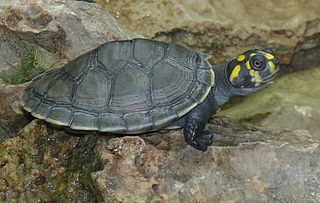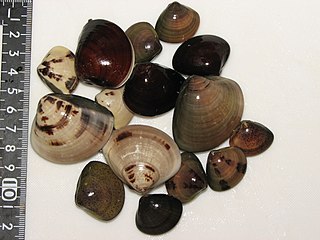
Paucituberculata is an order of South American marsupials. Although currently represented only by the seven living species of shrew opossums, this order was formerly much more diverse, with more than 60 extinct species named from the fossil record, particularly from the late Oligocene to early Miocene epochs. The earliest paucituberculatans date to the late Paleocene. The group went through a pronounced decline in the middle Miocene epoch, which resulted in the extinction of all families of this order except for the living shrew opossums (Caenolestidae). Extinct families of Paucituberculatans include Pichipilidae, Palaeothentidae, and Abderitidae.

Podocnemididae is a family of pleurodire (side-necked) turtles, once widely distributed. Most of its 41 genera and 57 species are now extinct. Seven of its eight surviving species are native to South America: the genus Peltocephalus, with two species, only one of which is extant ; and the genus Podocnemis, with six living species of South American side-necked river turtles and four extinct. There is also one genus native to Madagascar: Erymnochelys, the Madagascan big-headed turtle, whose single species E. madagascariensis.

Sparassodonta is an extinct order of carnivorous metatherian mammals native to South America, related to modern marsupials. They were once considered to be true marsupials, but are now thought to be a separate side branch that split before the last common ancestor of all modern marsupials.

Trigonostylops is an extinct genus of South American meridiungulatan ungulate, from the Late Paleocene to Late Eocene of South America and Antarctica. It is the only member of the family Trigonostylopidae.

Bothremydidae is an extinct family of side-necked turtles (Pleurodira) known from the Cretaceous and Cenozoic. They are closely related to Podocnemididae, and are amongst the most widely distributed pleurodire groups, with their fossils having been found in Africa, India, the Middle East, Europe, North America and South America. Bothremydids were aquatic turtles with a high morphological diversity, indicative of generalist, molluscivorous, piscivorous and possibly herbivorous grazing diets, with some probably capable of suction feeding. Unlike modern pleurodires, which are exclusively freshwater, bothremydids inhabited freshwater, marine and coastal environments. Their marine habits allowed bothremydids to disperse across oceanic barriers into Europe and North America during the early Late Cretaceous (Cenomanian). The youngest records of the group are indeterminate remains from Saudi Arabia and Oman, dating to the Miocene.

Herpetotheriidae is an extinct family of metatherians, closely related to marsupials. Species of this family are generally reconstructed as terrestrial, and are considered morphologically similar to modern opossums. They are suggested to have been insectivores. Fossils of herpetotheriids come from North America, Asia, Europe, Africa, and perhaps South America. The oldest representative is Maastrichtidelphys from the latest Cretaceous (Maastrichtian) of the Netherlands and the youngest member is Amphiperatherium from the Middle Miocene of Europe. The group has been suggested to be paraphyletic, with an analysis of petrosal anatomy finding that North American Herpetotherium was more closely related to marsupials than the European Peratherium and Amphiperatherium.

Meretrix lyrata, the lyrate Asiatic hard clam, also known simply as the hard clam, is an edible saltwater clam, a marine bivalve mollusc in the family Veneridae, the Venus clams.
The South American land mammal ages (SALMA) establish a geologic timescale for prehistoric South American fauna beginning 64.5 Ma during the Paleocene and continuing through to the Late Pleistocene. These periods are referred to as ages, stages, or intervals and were established using geographic place names where fossil materials where obtained.
The Tiupampan age is a period of geologic time within the Paleocene epoch of the Paleogene used more specifically with South American land mammal ages (SALMA). It is the oldest SALMA age and precedes the Peligran age.

The Itaboraian age is a period within the Early Eocene geologic time epoch of the Paleogene, used more specifically with South American land mammal ages (SALMA). It follows the Riochican and precedes the Casamayoran age.
The Casamayoran age is a period of geologic time within the Early Eocene epoch of the Paleogene, used more specifically within the South American land mammal age (SALMA) classification. It follows the Itaboraian and precedes the Mustersan age.
The Mustersan age is a period of geologic time within the Eocene epoch of the Paleogene, used more specifically within the South American land mammal age (SALMA) classification. It follows the Casamayoran and precedes the Divisaderan age.
The Divisaderan age is a South American land mammal age, covering a period of geologic time within the Middle and Late Eocene epochs of the Paleogene. It follows the Mustersan age and is followed by the Tinguirirican age.

Meretrix lusoria, the hamaguri, Asian hard clam or common Orient clam, is a species of saltwater clam, a marine bivalve mollusk in the family Veneridae, the Venus clams. This species is native to Asia, originally described around the waters of Japan. It is commercially exploited for sushi, and its shells are traditionally used to make white go stones.

Pholadomya is a genus of saltwater clams, marine bivalve molluscs in the family Pholadomyidae.
The Nanjemoy Formation is a geologic formation pertaining to both the Wilcox Group and the Pamunkey Group of the eastern United States, stretching across the states of Virginia, Maryland, and District of Columbia. The formation crops out east of the Appalachians and dates back to the Paleogene period. Specifically to the Ypresian stage of the Eocene epoch, about 55 to 50 Ma or Wasatchian in the NALMA classification, defined by the contemporaneous Wasatch Formation of the Pacific US coast.
The Lizard Springs Formation is a geologic formation in Trinidad and Tobago. It preserves fossils dating back to the Paleocene to Early Eocene period.
The Cañadón Asfalto Basin is an irregularly shaped sedimentary basin located in north-central Patagonia, Argentina. The basin stretches from and partly covers the North Patagonian Massif in the north, a high forming the boundary of the basin with the Neuquén Basin in the northwest, to the Cotricó High in the south, separating the basin from the Golfo San Jorge Basin. It is located in the southern part of Río Negro Province and northern part of Chubut Province. The eastern boundary of the basin is the North Patagonian Massif separating it from the offshore Valdés Basin and it is bound in the west by the Patagonian Andes, separating it from the small Ñirihuau Basin.
Cocatherium is an extinct genus of marsupial mammals of uncertain family placement, from the earliest Paleocene of South America, predating the Tiupampan South American land mammal age. The genus was described based on a fossil molar that was found in the Danian part of the Cretaceous-Paleogene Lefipán Formation in the Cañadón Asfalto Basin in north-central Patagonia, Argentina. The type species of the genus is C. lefipanum.
Sindhochelys is a genus of extinct turtle of the family Bothremydidae. It lived during the early Paleocene in what is known Sindh, Pakistan. The genus was discovered in the Khadro Formation and named in December 2021. The genus represents the first known member of its family in Pakistan. The family Bothremydidae lived from the Cenomanian of the early Cretaceous to the Miocene epoch.











